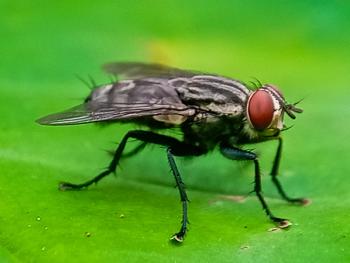
Spotlight on Lyme disease
Dr. Susan E. Little address the epidemiology and treatment of this tick-borne disease.
Editor's Note: Susan E. Little, DVM, PhD, Dipl. EVPC, holds the Krull-Ewing Endowed Chair in Veterinary Parasitology at the Department of Veterinary Pathobiology, Center for Veterinary Health Sciences at Oklahoma State University. From 2008 to 2009, she served as the president of the American Association of Veterinary Parasitologists. She has written more than 100 articles on veterinary and human parasites and tick-borne disease agents. And she has been awarded two Excellence in Teaching Awards from the national Student American Veterinary Medical Association.
Dr. Susan
DVM: Is Lyme disease increasing?
Little: We don't know because we don't have a reporting system similar to that used in humans to track the numbers. But cases in people are increasing, so if we use the humans as a sentinel of canine disease, then we would expect that the numbers of infected dogs are increasing. And areas of transmission also appear to be increasing as the maintenance cycles slowly spread into areas where Lyme borreliosis wasn't previously endemic. In people, the case reports are coming from a larger number of counties and states than in previous years. The focus remains the same, with the majority of cases from the Northeast and upper Midwest and a few from the West Coast. But in recent years, we've seen more cases cropping up around the Great Lakes area and down the East Coast to as far south as North Carolina, but no laboratory-confirmed reports of infections have been seen yet in the deep South.
Tick troubles: Cases of Lyme disease are cropping up in more and more areas across the United States. Remember: High deer numbers mean high tick numbers.(COMSTOCK/GETTY IMAGES)
DVM: Is there any new information or new findings about Lyme disease that veterinarians should know about?
Little: Well, certainly awareness of spread is important, especially if you are practicing in an area where transmission has only recently been recognized. Practice protocols may need to be updated with a renewed emphasis on tick control and perhaps periodic reconsideration about recommendations for vaccination. But I think it is also important that veterinarians remain aware of the prevalence of coinfection from other pathogens in dogs that test positive for Borrelia burgdorferi antibodies. We can't afford to stop looking for or considering coinfections once we make that initial diagnosis of a single tick-borne illness, like Lyme disease. If an animal has one tick-related infection, it may well have others. Coinfection should be particularly suspected when a patient fails to respond as expected to treatment for a single diagnosis.
DVM: Other than dogs, which other animals are most likely to contract Lyme disease?
Little: Horses are often infected in endemic areas, and recent case reports suggest this infection can cause neurologic disease and other clinical disease in some horses. As with dogs, not every animal infected will develop clinical Lyme disease. Antibodies to B. burgdorferi have also been reported in cats and cattle, but we don't have clear evidence of clinical disease associated with the infection.
DVM: I've read it's white-tailed deer and white-footed mice that are the primary maintenance hosts for the deer tick and the primary reservoirs for the B. burgdorferi infection. Is that still accurate?
Little: The white-tailed deer is the cornerstone species that supports the tick populations and, thus, allows transmission of Lyme borreliosis. Adult black-legged ticks thrive when deer are present, and since this is the reproductive stage, high deer numbers mean high tick numbers. The immature ticks feed on and acquire B. burgdorferi from rodents, but some recent data shows that other small mammals, like shrews and chipmunks, are just as important or even more important reservoir hosts in some regions.
DVM: We know the initial signs in people include the characteristic skin rash and flu-like symptoms. Are the signs the same in animals? What should animal owners and veterinarians be looking for?
Little: Dogs don't develop that characteristic rash of erythema migrans. In fact, in most cases dogs don't develop much illness from acute infection at all. So we often don't see dogs with Lyme disease until several months after exposure, once the arthritis or other condition from long-term, established infection has developed. The classic presentation is an otherwise healthy dog with recent onset of polyarthritis that may migrate, resulting in a shifting leg lameness, and without any other explanation such as trauma.
DVM: Doesn't that make it hard to diagnose in older dogs then?
Little: Yes, it can present a challenge. We diagnose by testing for specific antibodies to B. burgdorferi, but it is widely thought that the majority, perhaps as many as 95 percent, of dogs that test positive for the antibodies won't develop disease. Those that do are likely to develop chronic or recurrent polyarthritis, but a minority may develop the more severe renal nephritis or Lyme glomerulonephritis, which is potentially fatal.
DVM: Is serologic testing helpful, or is it often nonspecific in diagnosis?
Little: In clinical situations in which you have signs of disease and a suspected diagnosis, serology can help confirm the diagnosis of Lyme disease. We also have access to a quantitative C6 assay that can determine the level of antibodies present and help the veterinarian decide if there is an active, ongoing infection. The quantitative C6 test can also be used to monitor response to treatment. Because so many dogs in endemic areas have antibodies to B. burgdorferi, there can be a tendency to overdiagnose the disease. But if a dog has the characteristic signs, has antibodies at a level consistent with active or recent infection and responds to treatment, that certainly supports the clinical diagnosis.
DVM: What is the treatment of choice?
Little: Doxycycline is the treatment of choice. Other antibiotics, such as penicillin, are also effective, but those won't treat the rickettsial coinfections we often see with B. burgdorferi infection, such as ehrlichiosis or anaplasmosis.
DVM: In an animal not diagnosed and treated, what are the long-term effects of infection?
Little: As I noted, most dogs that are infected do not go on to develop disease, which is why it is recommended that veterinarians not routinely treat a healthy dog based on the presence of antibodies alone. Some veterinarians may decide to treat a recently infected dog—a dog that had previously tested negative—to try to prevent the illness that can be associated with allowing an infection to persist, but repeated treatments to clear antibodies from a dog that does not have any clinical disease are not indicated.
DVM: Any new and promising vaccinations or acaricides in development?
Little: On the market now are several effective vaccines for Lyme disease. As for acaricides, K9 Advantix II (Bayer) has a label change from its previous version that states the product can be used as always, applied once monthly, but that it also can be used as often as weekly in dogs. More frequent application of acaricides is occasionally indicated when dogs are exposed to overwhelming or extreme environmental tick infestations. Effective acaricides for our equine patients is a tougher problem, as horses tend to sweat and shed the chemicals, so the acaricides don't have the duration we would like in horses.
DVM: Are there any myths in the veterinary field about the disease that you'd like to dispel?
Little: Actually, to their great credit, most veterinarians I talk with today are educated and informed about Lyme disease. We are still troubled by all the things we don't know and don't understand, but it isn't so much myth as the need for more research to clarify certain issues. I am occasionally asked about the significance of a positive C6 test result, the antigen on the 3DX or 4DX Snap (IDEXX), in a vaccinated dog. Vaccination will not cause the test to become positive—only active or recent infection does that—but since the vaccines we have are not 100 percent effective at preventing infection, occasionally vaccinated dogs that are then exposed to ticks will test positive.
DVM: Other than diligent tick control, what prevention advice would you offer to large-animal owners, as well as pet owners?
Little: Modifying an animal's habitat to discourage tick populations can really support the efficacy of any tick-control product used because it limits the number of ticks the animals are exposed to and, thus, the risk of infection. If an animal is often in or around a wooded area in a region endemic for Lyme disease, the chances are greater the animal will be infected. If the owner can limit the amount of time the animal is exposed to ticks, that's better. Maintaining pastures; limiting the incursion of understory and brushy, wooded habitat; or keeping a dog in a manicured yard rather than letting it run free on several wooded acres can really help decrease the numbers of ticks an animal encounters. For example, a weekly walk in the woods with an owner present, so long as acaricides are used, may be OK. But if the owner lets the dog have unlimited access to five or 10 acres of wooded land all day every day, that could be problematic.
DVM: Are any acaricides more effective in preventing Lyme disease than others?
Little: Those products that offer persistent control, more comprehensive coverage, are better than any short-acting over-the-counter products applied by the owner after a tick is found on an animal or after infestations have already established. The important thing is to apply the persistent products routinely. Once ticks are present, it's too late. Like most of us, I would always prefer to kill the ticks as soon as possible, preferably before they attach.
DVM: How did you get interested in parasitology and what do you like about the field?
Little: In my second year of veterinary school, I took a parasitology course, and I was really fascinated by the stories of parasites—the way they move through multiple hosts to complete their life cycle and how they use other animals as their ecological niche. But what keeps me excited about parasites and parasitology is that the field is constantly changing; there's always new information, new discoveries to be made. Plus, it's an area of veterinary medicine that has very practical applications. The progress we make in understanding parasites and vector-borne disease systems can effect change and have a real impact on the life and health of animals and people.
DVM: Tell us about your research on Lyme disease.
Little: Our research group focuses on the natural history of ticks and tick-borne pathogens in North America with a goal of furthering understanding of the factors that conspire to maintain a cycle of tick-borne pathogens in nature and that ultimately provide the source of infection to people and dogs. In the last few years, we have focused largely on ehrlichiosis and borreliosis because of the importance those diseases have for the health of people and dogs. We also work on hepatozoonosis, a devastating disease in dogs in the southern United States with an expanding distribution. Our broad goals are to understand the interactions between reservoir hosts and tick vectors important in the transmission cycles, to map where the infections are occurring and to establish evidence-based methods of prevention.
DVM: What research are you working on?
Little: We have a variety of ongoing projects in ehrlichiosis, borreliosis and hepatozoonosis, all geared toward trying to better understand the natural transmission cycles of pathogens in nature and from ticks to pets and people.
Donna Loyle is a freelance medical editor and writer in Philadelphia and the former primary editor of the North American Veterinary Licensing Examination.
Newsletter
From exam room tips to practice management insights, get trusted veterinary news delivered straight to your inbox—subscribe to dvm360.





